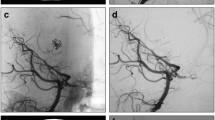Abstract
Background
This report described the surgical resection of a challenging medial parietal lobe arteriovenous malformation (AVM) using the hybrid operation theater with a multimodal imaging-guided technology.
Method
A 29-year-old male was admitted to treat a ruptured medial parietal AVM. The deep and diffusive compartment of the nidus was embolized before resection. Preoperatively and intraoperatively, mixed reality technology with multimodality imaging was utilized for surgical planning and navigation. The nidus was totally resected and confirmed by intraoperative angiography. The patient recovered without sequella.
Conclusion
We hope this report provides new insights into applying multimodal imaging technology-guided hybrid operation for brain AVM.



Similar content being viewed by others
References
Aldea S, Consoli A, Rodesch G, Gaillard S (2020) Multimodal management of a ruptured right medial parietal arteriovenous malformation: 2-dimensional operative video. Oper Neurosurg (Hagerstown) 18:E14–E15
Brunozzi D, Stone McGuire L, Hossa J, Atwal G, Charbel FT, Alaraj A (2023) Preoperative embolization of brain arteriovenous malformation and efficacy in intraoperative blood loss reduction: a quantitative study. J Neurointerv Surg (Online ahead of print)
Burkhardt JK, Winkler EA, Lawton MT (2018) Contralateral posterior interhemispheric approach to deep medial parietooccipital vascular malformations: surgical technique and results. J Neurosurg 129:198–204
Gruter BE, Mendelowitsch I, Diepers M, Remonda L, Fandino J, Marbacher S (2018) Combined endovascular and microsurgical treatment of arteriovenous malformations in the hybrid operating room. World Neurosurg 117:e204–e214
Korja M, Bervini D, Assaad N, Morgan MK (2014) Role of surgery in the management of brain arteriovenous malformations: prospective cohort study. Stroke 45:3549–3555
Quan K, Liu Y, Wang Y, Tian Y, Xu B, Li P, Liu P, Shi Y, Hu L, Xu G, Luo J, Song J, Zhu W (2023) Treatment of high-grade brain arteriovenous malformations using a hybrid operating room: a prospective single-arm study. Clin Neurol Neurosurg 224:107517
Rhoton AL Jr (2007) The cerebrum. Anatomy. Neurosurgery 61:37–118 discussion 118-119
Song J, Li P, Tian Y, An Q, Liu Y, Yang Z, Chen L, Quan K, Gu Y, Ni W, Zhu W, Mao Y (2020) One-stage treatment in a hybrid operation room to cure brain arteriovenous malformation: a single-center experience. World Neurosurg 147:e85–e97
Yue Q, Zhu W, Gu Y, Xu B, Lang L, Song J, Cai J, Xu G, Chen L, Mao Y (2014) Motor evoked potential monitoring during surgery of middle cerebral artery aneurysms: a cohort study. World Neurosurg 82:1091–1099
Acknowledgements
This study was sponsored by the Shanghai Municipal Alliance for Clinical Competence Improvement and Advancement in Neurosurgery (SHDC22021303), the Fujian Province Science and Technology Innovation Joint Fund (No. 2021Y9135), and Pudong New Area Science and Technology Development Fund (No. PKX2020-R03). The mixed reality planning is courtesy of Shanghai Licyo Medical Technology Co., LTD. The DTI images in this manuscript were reconstructed using an automatic algorithm software “DiffusionGo.”
Author information
Authors and Affiliations
Corresponding author
Ethics declarations
Conflict of interest
The authors declare no competing interests.
Research involving human participants
All procedures performed in studies involving human participants were in accordance with the ethical standards of the institutional research committee and with the 1964 Helsinki Declaration and its later amendments or comparable ethical standards. The study was approved by Huashan Hospital Institutional Review Board (HIRB), Fudan University, Shanghai, China.
Informed consent
It represents a video of a surgical case. The patient gave approval for this publication.
Additional information
Publisher’s Note
Springer Nature remains neutral with regard to jurisdictional claims in published maps and institutional affiliations.
Key points
1. Surgical resection of medial parietal AVMs can be challenging due to their location and proximity to eloquent structures.
2. The distal cortical branches of the ACA and PCA are the main suppliers of medial parietal AVMs.
3. The drainage route for medial parietal AVMs can be either superficial or deep, ascending towards the SSS and/or descending towards the VoG.
4. Medial parietal AVMs invading the paracentral lobule are considered eloquent, as they are associated with the somatosensory cortex responsible for leg sensation.
5. The hybrid operation theater can ensure safe, comprehensive multimodality evaluation and treatment of brain AVM, offering the opportunity for favorable curative treatment.
6. The mixed reality technology can be utilized to understand surgical anatomy and plan thoroughly.
7. Embolization through the PCA can be used to occlude the most diffusive and deepest compartment of the medial parietal AVM.
8. Temporary clipping of the primary suppliers to the nidus is the key for early proximal control during surgery.
9. Careful dissection and inspection are crucial to prevent contralateral ACA and PCA injury.
10. The drainage veins should only be transected after most of the nidus was circumstantially devascularized.
Supplementary information
This video illustrates the set-up of the position under the guidance of Hololens 2 and the surgical procedure of a right medial parietal AVM resection. (MP4 117101 kb)
Rights and permissions
Springer Nature or its licensor (e.g. a society or other partner) holds exclusive rights to this article under a publishing agreement with the author(s) or other rightsholder(s); author self-archiving of the accepted manuscript version of this article is solely governed by the terms of such publishing agreement and applicable law.
About this article
Cite this article
Quan, K., Qin, X., Song, J. et al. How we do it? The surgical resection of a medial parietal arteriovenous malformation under multimodal imaging technology-guided hybrid operation. Acta Neurochir 165, 3787–3791 (2023). https://doi.org/10.1007/s00701-023-05836-8
Received:
Accepted:
Published:
Issue Date:
DOI: https://doi.org/10.1007/s00701-023-05836-8




